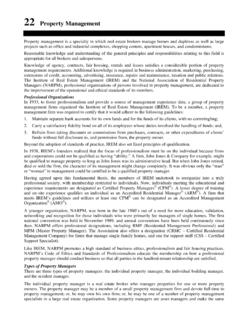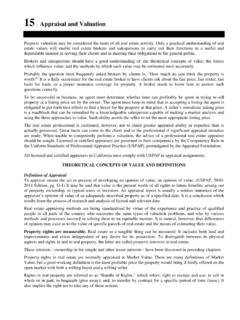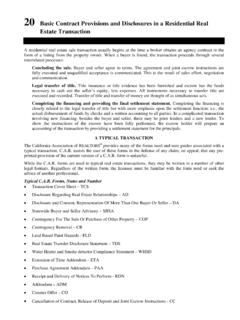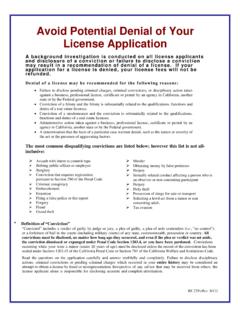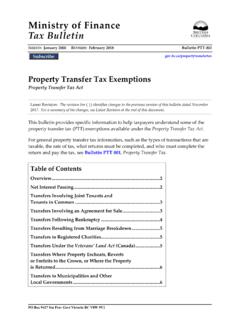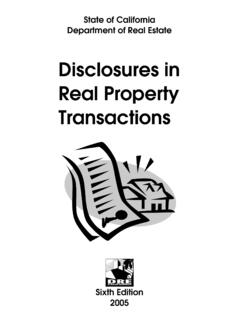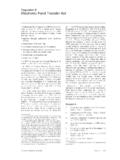Transcription of 7. Principal Instruments of Transfer
1 7 Principal Instruments Of Transfer A Backward Look Under the early English common law, ownership of real property was transferred by a technique called feoffment. This involved delivery of possession, which was termed livery of seizin. No writing or deed was involved. The Transfer was actually effected by a delivery of the land itself or something symbolical of the land, such as a twig, a stone, or a handful of dirt. Another early method of Transfer was by a statement usually made before witnesses in view of the land to the effect that possession was transferred, followed by entry of the new owner. Again, no written instrument was at first required. An interest in land which was not capable of actual possession (termed an incorporeal right), such as an easement, was transferred by a deed called a deed of grant.
2 A conveyance by a release was a deed given to Transfer an estate or interest in land, but no livery of seizin . could be given until the new owner took possession, which involved a multiplicity of formalities. A release was also used for the purpose of extinguishing a right in the land and corresponds to its modern descendant, the quitclaim deed. A recording system was unknown to the early common law. Ownership was a matter of common knowledge and Transfer was not often made except by descent from father to son on the father's death. The method of making land transfers in California under Spanish and Mexican rule was somewhat similar to that of the common law. It was early held by the Supreme Court of California that land could not be conveyed under Spanish and Mexican laws without an instrument in writing, unless conveyance of the land was made by an executed contract in which actual possession was delivered at the time of sale by entry upon the premises and the doing of certain ceremonial acts (which in a sense were like livery of seizin at common law).
3 The ancient livery of seizin is symbolized today by the delivery of the deed, not the property, by the grantor to the grantee. The deed is the now the symbol of title. The Pattern Today Today, Californians most often Transfer title to real property by a simple written instrument, the grant deed. The word grant is expressly designated by statute as a word of conveyance. (Civil Code Section 1092) A second form of deed is the quitclaim deed. It resembles the common law conveyance by a release. Other types of deeds are the warranty deed, the trust deed, the reconveyance deed, the sheriff's deed, and the gift deed. DEEDS IN GENERAL. When properly executed, delivered and accepted, a deed transfers title to real property from one person (the grantor) to another person (the grantee).
4 Transfer may be voluntary, or involuntary by act of law, such as a foreclosure sale. There are several different essentials to a valid deed: 1. It must be in writing;. 2. The parties must be properly described;. 3. The parties must be competent to convey and capable of receiving the grant of the property;. 4. The property conveyed must be described so as to distinguish it from other parcels of real property.;. 5. There must be a granting clause, operative words of conveyance ( , I hereby grant );. 6. The deed must be signed by the party or parties making the conveyance or grant; and 7. It must be delivered and accepted. Contrary to the law and established custom in other states, the expression to have and to hold (called the habendum clause of a deed) is not necessary, nor are witnesses or seal required.
5 The deed should be dated, but this too is not necessary to its validity. Any form of written instrument containing the essentials above set out will convey title to land. A typical grant 112 CHAPTER SEVEN. deed may be in the form as follows: I, John A. Doe, a single man, grant to Emma B. Roe, a widow, all that real property situated in Sacramento County, State of California, described as follows: Lot 21, Tract 62, recorded at Page 91 of Book 7 of Maps of Sacramento County, filed January 21, 1965. Witness my hand this tenth day of October, 1983. (Signed) John A. Doe . Usually, a deed is executed for consideration, but this is not essential for a valid Transfer . Moreover, even when consideration is given for the property, this point need not be mentioned in the deed.
6 However, it should be noted that lack of consideration may affect the rights of the grantee as against the rights of certain third parties because the recording statutes are intended to protect bona fide purchasers. For example, a Transfer made without consideration by a grantor who is or will thereby be rendered insolvent, is fraudulent as to grantor's creditors and those creditors may have the deed set aside in a court action. A deed need not be acknowledged, nor need it be recorded. However, both acknowledgment and recordation are part of the standard operating procedure in real estate transfers for very good reasons. Acknowledgment An acknowledgment is a formal declaration before a duly authorized officer, such as a notary public, by a person who has executed an instrument that such execution is his or her act and deed.
7 The piece of paper (or form) executed by the officer before whom the formal declaration was made (for example, the grantor in a grant deed) is a Certificate of Acknowledgment. This certificate is either printed right on the grant deed itself or is a separate piece of paper which is stapled to the grant deed. The acknowledgment of a writing is a way of proving that the writing was in fact signed (or executed) by the person who purported to sign (or execute) the writing. Moreover, an acknowledgment is a safeguard against forgery and false impersonation. Duly acknowledged writings are entitled to be introduced into evidence in litigation without further proof of execution.
8 Many Instruments are not entitled to be recorded unless acknowledged. Unless by statute an acknowledgment is made essential to the validity of an instrument, the instrument itself is valid between the parties and persons having actual notice of it, though not acknowledged. The time of acknowledgment is almost invariably immaterial if the rights of innocent third parties do not intervene. Where acknowledgments may be taken and by whom. Anywhere within the state, proof or acknowledgment of an instrument may be made before a justice, retired justice or clerk of the Supreme Court, or District Court of Appeal, or the judge or retired judge of a superior court, or, after September 17, 1959, a notary public.
9 (Before that date a notary could not act outside the notary's own county.). In this state and within the city, county, city and county, or district for which the officer was selected, or appointed, acknowledgment of an instrument may be made before either: a clerk of a municipal or justice court;. a county clerk; a court commissioner; a judge or retired judge of a superior, municipal or justice court or certain other local officials. (Civil Code Section 1181). Acknowledgments may be made and taken by any deputy of the foregoing, duly authorized by law. Also, certain military officers are authorized to take acknowledgments of persons serving in the armed forces. (Civil Code Section ).
10 The Principal form of acknowledgement authorized by California law is provided for in Civil Code Section An acknowledgment taken outside this state, must be in accordance with the forms, provisions, and laws of this state. If not, it should have attached thereto a certificate of a clerk of the court of record of the county or district where the same was taken, or of a consul or consular agent of the , or judge if in a foreign country. The certificate of acknowledgment must state that it is in accordance with the laws of the state, the United States or the foreign country in which it was taken and that the officer taking the same was authorized by law to do so and that the signature is true and genuine.
